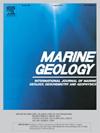Longitudinal transport of net suspended sediment in the river-dominated Modaomen Estuary of the Pearl River: Effects of river, tide, and mouth bar
IF 2.2
3区 地球科学
Q2 GEOSCIENCES, MULTIDISCIPLINARY
引用次数: 0
Abstract
The suspended sediment dynamics in estuaries are strongly affected by the interaction of rivers, tides, and morphological factors. However, little is known about the combined impact of these driving factors on longitudinal net sediment transport. A field investigation of current velocity, salinity, and suspended sediment concentration (SSC) was conducted in the Modaomen Estuary of the Pearl River. Hydrological data were simultaneously measured at three mooring stations in the longitudinal direction on July 31, and August 8, 2017, covering a neap tide and a spring tide. Net suspended sediment transport patterns were also analyzed. Current velocity, SSC, and salinity exhibited spatial and temporal variations during the spring–neap tides. Seaward net sediment transport was dominant during the observation period and, vertically, double patterns of net sediment transport inside and outside the mouth bar appeared to occur in the longitudinal profile. The net sediment flux can be divided into three major components—advection sediment transport, tidal-pumping, and vertical circulation. Of these, seaward sediment advection was the dominant component, which generally conformed to the dynamic characteristics in a river-dominated estuary. Salinity intrusion into the bottom layer caused stratification, inhibited vertical diffusion, and enhanced sediment settling, resulting in an elevated SSC in the bottom layer at the mouth bar. Eulerian residual flow primarily contributed to the seaward advection transport. Tidal asymmetries during the ebb–flood tidal cycle enhanced tidal-pumping sediment transport, and the main driving factor, SSC asymmetry, corresponded well with sediment flux. The mouth bar exerted a significant morphological effect on salinity intrusion and promoted longitudinal estuarine circulation, thus affecting longitudinal sediment transport. Our results contribute to a better understanding of the underlying mechanism of suspended sediment transport in complex dynamic environments as well as the feedback between the hydrodynamic structure and morphology in estuaries, facilitating the development of evidence-based guidelines for estuarine and coastal engineering and management.
珠江口磨道门净悬沙纵向输移:河流、潮汐和河口坝的影响
河口悬沙动力学受河流、潮汐和地貌因素的相互作用的强烈影响。然而,这些驱动因素对纵向净输沙的综合影响知之甚少。在珠江口磨道门进行了流速、盐度和悬浮沙浓度(SSC)的野外调查。2017年7月31日和8月8日在三个系泊站纵向同步测量水文数据,包括小潮和大潮。同时分析了净悬沙输运模式。大潮小潮期间,海流流速、海温和盐度呈现时空变化特征。观测期间以向海净输沙为主,纵向上呈现河口坝内外双重净输沙格局。净输沙通量可分为平流输沙、潮汐抽沙和垂直环流三个主要组成部分。其中,向海沉积物平流为主导成分,基本符合河流主导型河口的动力特征。盐度侵入底层引起分层,抑制垂向扩散,增强沉积物沉降,导致河口沙洲底层SSC升高。欧拉残余流对向海平流输送起主要作用。退潮-涨潮周期的潮汐不对称增强了抽潮输沙,主要驱动因子SSC不对称与输沙通量有较好的对应关系。河口坝对盐度入侵具有显著的形态影响,促进河口纵向环流,从而影响纵向输沙。我们的研究结果有助于更好地理解复杂动力环境下悬沙运移的潜在机制,以及河口水动力结构与形态之间的反馈,促进河口和海岸工程与管理的循证指南的发展。
本文章由计算机程序翻译,如有差异,请以英文原文为准。
求助全文
约1分钟内获得全文
求助全文
来源期刊

Marine Geology
地学-地球科学综合
CiteScore
6.10
自引率
6.90%
发文量
175
审稿时长
21.9 weeks
期刊介绍:
Marine Geology is the premier international journal on marine geological processes in the broadest sense. We seek papers that are comprehensive, interdisciplinary and synthetic that will be lasting contributions to the field. Although most papers are based on regional studies, they must demonstrate new findings of international significance. We accept papers on subjects as diverse as seafloor hydrothermal systems, beach dynamics, early diagenesis, microbiological studies in sediments, palaeoclimate studies and geophysical studies of the seabed. We encourage papers that address emerging new fields, for example the influence of anthropogenic processes on coastal/marine geology and coastal/marine geoarchaeology. We insist that the papers are concerned with the marine realm and that they deal with geology: with rocks, sediments, and physical and chemical processes affecting them. Papers should address scientific hypotheses: highly descriptive data compilations or papers that deal only with marine management and risk assessment should be submitted to other journals. Papers on laboratory or modelling studies must demonstrate direct relevance to marine processes or deposits. The primary criteria for acceptance of papers is that the science is of high quality, novel, significant, and of broad international interest.
 求助内容:
求助内容: 应助结果提醒方式:
应助结果提醒方式:


